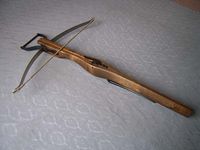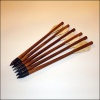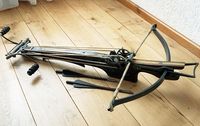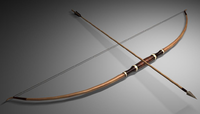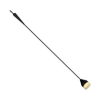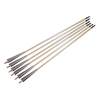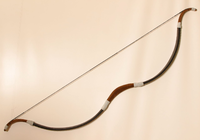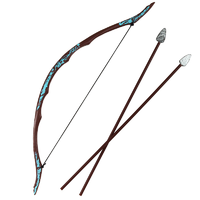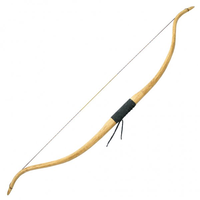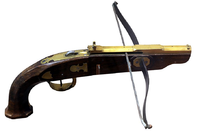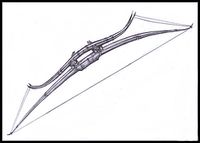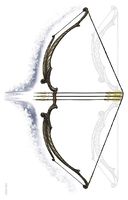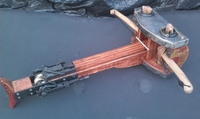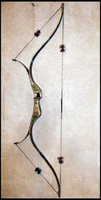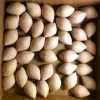|
|
| Line 1: |
Line 1: |
| [[Category:Epic Path]] | | [[Category:Epic Path]] |
| | | <div style="clear">__TOC__</div> |
| == Simple Projectile Weapons == | | == Simple Projectile Weapons == |
|
| |
|
Revision as of 16:00, 14 August 2018
Simple Projectile Weapons
| Light Crossbow |
2-Hand Projectile / Simple |
[edit]
|
|
Cost |
Sm Dmg |
Med Dmg |
Large Dmg |
Crit |
Range |
Wt |
Type
|
| 35 gp |
see ammo |
see ammo |
see ammo |
see ammo |
see ammo |
4 lbs |
Piercing (physical, common) or by ammunition
|
| Weapon Qualities: Mighty, Non-Melee
|
| You draw a light crossbow back by pulling a lever. Normally, operating a light crossbow requires two hands. However, you can shoot, but not load, a light crossbow with one hand at a -2 penalty on attack rolls. You can shoot a light crossbow with each hand, but you take a penalty on attack rolls as if attacking with two one-handed weapons. This penalty is cumulative with the penalty for one-handed firing. Light crossbows can be purchased in higher draw weights to match the Strength bonus of the wielder. This costs 35 gp per Strength mod plus added.
Load: Loading a light crossbow can be performed with either a move action or an attack action. The reload time can be reduced by taking the Rapid Reload (Feat).
The light crossbow belongs to the "Crossbows" weapon group.
|
Show / Hide Ammunition Types
|
Ammo Type |
Cost |
Sm Dmg |
Med Dmg |
Large Dmg |
Crit |
Range |
Wt |
Type
|
| Crossbow Bolt |
1 sp each |
1d6 |
1d8 |
2d6 |
19-20 / x2 |
80 ft |
0.1 lbs each |
Piercing (physical, common)
|
| Weapon Qualities: Expendable
|
| Crossbow bolts are thick, graceless things compared to arrows. In keeping with the simplicity of the crossbow, the bolts are not sophisticated, either. Arrows must be carefully made with just the right amount of flex, or spine, in the long, slim shafts. Bolts are far too thick and short to flex, even under the brutal firing conditions of heavy crossbows or hand onagers. Bolts have simple conical tips hammered of mild steel, massive shafts of heavy, cheap woods like greenheart, swamp oak, or sycamore, and durable fletching made of thin sections of cherry or pine. They take little to no skill to make, but they do have to be consistently made, so they are all the same size. Despite their low sophistication, nobody can argue that bolts lack in power, and they have won many, many battles.
|
|
Ammo Type |
Cost |
Sm Dmg |
Med Dmg |
Large Dmg |
Crit |
Range |
Wt |
Type
|
| Barbed Bolt |
5 gp each |
1d8 |
1d10 |
2d8 |
19-20 / x2 |
40 ft |
0.25 lbs each |
Piercing (physical, common)
|
| Weapon Qualities: Expendable
|
| Barbed crossbow bolts are just about the nastiest things you'll ever see. They are stout, brutal devices, whose wicked barbs make the terrible wounds already inflicted by a crossbow much, much worse. Unlike normal bolts, barbed bolts are difficult to make and thus are expensive. They are typically made of the same woods as arrows, although in a thick, strong, graceless fashion, and are often fletched with thin shavings of horn or turtle shell. The massive barbed heads require considerable skill to forge and sharpen. Barbed bolts are heavier than standard bolts, and cannot be fired as far as standard bolts. Pointing a crossbow loaded with a barbed bolt at a someone is a very clear statement that you mean business.
|
|
Ammo Type |
Cost |
Sm Dmg |
Med Dmg |
Large Dmg |
Crit |
Range |
Wt |
Type
|
| Blunt Bolt |
5 cp each |
1d6 |
1d8 |
2d6 |
19-20 / x2 |
40 ft |
0.1 lbs each |
Bludgeoning (physical, common)
|
| Weapon Qualities: Expendable
|
| Blunt crossbow bolts have the simple conical tip of mild steel replaced by a small round bit of glued-on iron that covers the end of the thick wooden shaft. This means blunt bolts can be made without a blacksmith, just punched out bits of iron. As a result, the cost of blunt crossbow bolts is half that of standard bolts. Blunt bolts weigh the same and do the same amount of damage as regular bolts, although the range is halved. In a hand onager, blunt bolts grant the weapon the Sunder quality at range, since the Hand Onager is also a Siege Weapon.
|
| Heavy Crossbow |
2-Hand Projectile / Simple |
[edit]
|
|
Cost |
Sm Dmg |
Med Dmg |
Large Dmg |
Crit |
Range |
Wt |
Type
|
| 50 gp |
see ammo |
see ammo |
see ammo |
see ammo |
see ammo |
8 lbs |
Piercing (physical, common) or by ammunition
|
| Weapon Qualities: Mighty, Non-Melee
|
| You draw a heavy crossbow back by turning a small winch. Normally, operating a heavy crossbow requires two hands. However, you can shoot, but not load, a heavy crossbow with one hand at a -4 penalty on attack rolls. Despite this, due to their vigorous kick when fired, you cannot shoot a heavy crossbow with each hand. Heavy crossbows can be purchased in higher draw weights to match the Strength bonus of the wielder. This costs 50 gp per Strength mod plus added.
Load: Loading a heavy crossbow can be performed with either a move action or an attack action. The reload time can be reduced by taking the Rapid Reload (Feat).
The heavy crossbow belongs to the "Crossbows" weapon group.
|
Show / Hide Ammunition Types
|
Ammo Type |
Cost |
Sm Dmg |
Med Dmg |
Large Dmg |
Crit |
Range |
Wt |
Type
|
| Crossbow Bolt |
1 sp each |
1d8 |
1d10 |
2d8 |
19-20 / x2 |
120 ft |
0.1 lbs each |
Piercing (physical, common)
|
| Weapon Qualities: Expendable
|
| Crossbow bolts are thick, graceless things compared to arrows. In keeping with the simplicity of the crossbow, the bolts are not sophisticated, either. Arrows must be carefully made with just the right amount of flex, or spine, in the long, slim shafts. Bolts are far too thick and short to flex, even under the brutal firing conditions of heavy crossbows or hand onagers. Bolts have simple conical tips hammered of mild steel, massive shafts of heavy, cheap woods like greenheart, swamp oak, or sycamore, and durable fletching made of thin sections of cherry or pine. They take little to no skill to make, but they do have to be consistently made, so they are all the same size. Despite their low sophistication, nobody can argue that bolts lack in power, and they have won many, many battles.
|
|
Ammo Type |
Cost |
Sm Dmg |
Med Dmg |
Large Dmg |
Crit |
Range |
Wt |
Type
|
| Barbed Bolt |
5 gp each |
1d10 |
1d12 |
3d6 |
19-20 / x2 |
60 ft |
0.25 lbs each |
Piercing (physical, common)
|
| Weapon Qualities: Expendable
|
| Barbed crossbow bolts are just about the nastiest things you'll ever see. They are stout, brutal devices, whose wicked barbs make the terrible wounds already inflicted by a crossbow much, much worse. Unlike normal bolts, barbed bolts are difficult to make and thus are expensive. They are typically made of the same woods as arrows, although in a thick, strong, graceless fashion, and are often fletched with thin shavings of horn or turtle shell. The massive barbed heads require considerable skill to forge and sharpen. Barbed bolts are heavier than standard bolts, and cannot be fired as far as standard bolts. Pointing a crossbow loaded with a barbed bolt at a someone is a very clear statement that you mean business.
|
|
Ammo Type |
Cost |
Sm Dmg |
Med Dmg |
Large Dmg |
Crit |
Range |
Wt |
Type
|
| Blunt Bolt |
5 cp each |
1d8 |
1d10 |
2d8 |
19-20 / x2 |
60 ft |
0.1 lbs each |
Bludgeoning (physical, common)
|
| Weapon Qualities: Expendable
|
| Blunt crossbow bolts have the simple conical tip of mild steel replaced by a small round bit of glued-on iron that covers the end of the thick wooden shaft. This means blunt bolts can be made without a blacksmith, just punched out bits of iron. As a result, the cost of blunt crossbow bolts is half that of standard bolts. Blunt bolts weigh the same and do the same amount of damage as regular bolts, although the range is halved. In a hand onager, blunt bolts grant the weapon the Sunder quality at range, since the Hand Onager is also a Siege Weapon.
|
Martial Projectile Weapons
| Longbow |
2-Hand Projectile / Martial |
[edit]
|
|
Cost |
Sm Dmg |
Med Dmg |
Large Dmg |
Crit |
Range |
Wt |
Type
|
| 75 gp |
see ammo |
see ammo |
see ammo |
see ammo |
see ammo |
3 lbs |
Piercing (physical, common) or by ammunition
|
| Weapon Qualities: Non-Melee, Primitive Availability
|
| The longbow is a large, powerful simple bow, made of a single baulk of the properly selected and cured wood, bone, horn, or other strongly resilient material. They demand exquisite craftsmanship in forming them properly, but they need very little assembly.
You need two hands to use any bow, regardless of its size. A longbow is too unwieldy to use while you are mounted. If you have a penalty for low Strength, apply it to damage rolls when you use a longbow. If you have a Strength bonus, however, it is not applied to the longbow's damage.
The longbow has been invented many times by different cultures. All large simple bows, regardless of name, are longbows. The longbow belongs to the "Bows" weapon group.
|
Show / Hide Ammunition Types
|
Ammo Type |
Cost |
Sm Dmg |
Med Dmg |
Large Dmg |
Crit |
Range |
Wt |
Type
|
| Common Arrow |
5 cp each |
1d6 |
1d8 |
2d6 |
x3 |
100 ft |
0.1 lbs each |
Piercing (physical, common)
|
| Weapon Qualities: Expendable
|
| Common arrows are standard bow ammunition. They have sturdy diamond points on them, they're shafted with easy to get ash, maple, or willow, and they have reliable goose-feather fletchings. They do a bit less damage in shortbows than they do in longbows, and a bit less damage in longbows than they do in greatbows. A common arrow is denoted by that classic, deadly but easy to make, diamond-shaped point. It's good against armor, it's good against beasts, and it can be made quickly. You'll see these everywhere, and rightly so, because they're great.
|
|
Ammo Type |
Cost |
Sm Dmg |
Med Dmg |
Large Dmg |
Crit |
Range |
Wt |
Type
|
| Barbed Arrow |
2 gp each |
1d4 |
1d6 |
1d10 |
x3 |
50 ft |
0.5 lbs each |
Slashing (physical, common)
|
| Weapon Qualities: Expendable, Weapon Qualities: Special
|
| The barbed arrow is a specialty product, since making that extravagant head takes a lot of time and skill. Barbed arrows are based off broadhead arrows, with all their characteristics, but they do the same damage as flight arrows. So why bother with them? Because to remove a barbed arrowhead is a deadly and dangerous process. To remove a barbed arrow after you've been struck by one and taken damage past any DR requires greater than animal intelligence and a heal check against an Easy DC. Either the victim or an adjacent creature can attempt to remove barb heads. Failing the heal check means removing the barbed arrow inflicts 1d6 of additional damage which cannot be reduced by DR. Ouch.
|
|
Ammo Type |
Cost |
Sm Dmg |
Med Dmg |
Large Dmg |
Crit |
Range |
Wt |
Type
|
| Blunt Arrow |
5 sp each |
1d6 |
1d8 |
2d6 |
x3 |
50 ft |
0.5 lbs each |
Bludgeoning (physical, common)
|
| Weapon Qualities: Expendable
|
| Take a broadhead arrow and remove that big, deadly steel point. Replace it with a shaped boiled-leather cup into which a tightly rolled mass of cotton cloth is firmly wedged, presenting the firm, flat side of the roll toward the front of the arrow. What you get is the blunt arrow, which does bludgeoning damage rather than piercing damage. Why would you do this? Well, hunting of some delicate game species is easier with blunt arrows. Blunt arrows have the same construction as broadhead arrows, but to keep that heavy, flat tip pointed right, they suffer a reduced range increment.
|
|
Ammo Type |
Cost |
Sm Dmg |
Med Dmg |
Large Dmg |
Crit |
Range |
Wt |
Type
|
| Broadhead Arrow |
3 sp each |
1d8 |
1d10 |
2d8 |
x3 |
50 ft |
0.25 lbs each |
Piercing (physical, common)
|
| Weapon Qualities: Expendable
|
| The obvious difference to a broadhead arrow is the head, which is a heavy delta-shaped thing with sharp wings and modest barbs. They have more steel in them than common heads, and the blacksmith has to spend some time on them compared to diamond points. The shaft of the broadhead arrow is made of a dense, heavy wood like buckeye, hickory, or dogwood to maintain the proper spine with that heavy head on it. And instead of three fletchings a broadhead arrow has four, to keep that big-winged head pointed the right direction. As a result, broadheads are expensive, short-ranged, and weigh over twice as much as a standard arrow, but they hit really hard.
|
|
Ammo Type |
Cost |
Sm Dmg |
Med Dmg |
Large Dmg |
Crit |
Range |
Wt |
Type
|
| Flaming Arrow |
3 gp each |
1d4 |
1d6 |
1d10 |
x3 |
50 ft |
0.5 lbs each |
Piercing (physical, common)
|
| Weapon Qualities: Expendable
|
| Flaming arrows are an age-old terror weapon. Flaming arrows are based off broadheads, as the dense, hardwood shafts are required to allow them to do their fiery work. The massive broadhead is removed and replaced with a small needle-like head with a hole in it. Through the hole is threaded a soft rag of cotton, wool, or linen and the whole thing is soaked in tar and wrapped around the head and top of the shaft. This is allowed to cool into a solid, flammable mass. Lighting a flaming arrow requires a move action and access to a considerable source of flame (larger than a torch, such as a good fire or a brazier). Any amount of magical flame will touch one off, as well. Once lit, a flaming arrow burns for 5 rounds, regardless of wind or rain, although being underwater or doused by a bucket will extinguish it. Flaming arrows do piercing damage as above, as well as 1d4 of fire damage to creatures struck. When fired at flammable structures like cloth wagon covers, thatch roofs, haystacks, etc, they ignite such things automatically the next round unless doused. On light wooden structures they ignite on a 1-2 on a d6 roll. On heavy wooden structures they ignite after three rounds on a roll of 1 on a d10. See the Environmental Effects rules for how to put things out again. Fire Arrows get really scary when you fire a few hundred of them at once....
|
|
Ammo Type |
Cost |
Sm Dmg |
Med Dmg |
Large Dmg |
Crit |
Range |
Wt |
Type
|
| Flight Arrow |
5 sp each |
1d4 |
1d6 |
1d10 |
x3 |
150 ft |
0.05 lbs each |
Piercing (physical, common)
|
| Weapon Qualities: Expendable
|
| Flight arrows are designed for the maximum possible range. As a result, they use common diamond-tip arrowheads in good quality steel but in very small sizes. The shafts are made of kiln-dried lightweight woods, like alder, fir, spruce, or cedar. And the fletching is small, often made of chicken feathers rather than goose. The result is an arrow that is the same size as a regular arrow but weighs about half as much and is ridiculously streamlined. Flight arrows shoot like lightning, and are what are used in target shooting competitions.
|
|
Ammo Type |
Cost |
Sm Dmg |
Med Dmg |
Large Dmg |
Crit |
Range |
Wt |
Type
|
| Whistling Arrow |
1 gp each |
1d4 |
1d6 |
1d10 |
x3 |
100 ft |
0.1 lbs each |
Piercing (physical, common)
|
| Weapon Qualities: Expendable, Audible
|
| Take a common arrow, replace that simple but elegant diamond point with a whistling cage made of bent rod, and you create a whistling arrow. These are audible in flight to a distance of 50 feet from the path of their flight, so they're pretty darn loud. They make a distinctive falling shriek as they fly that sounds eerie, especially if you get a few hundred going all at once. Great fun, but expensive. Whistling arrows even do reasonable damage, since they have a functional chisel point atop the whistling cage.
|
| Composite Longbow |
2-Hand Projectile / Martial |
[edit]
|
|
Cost |
Sm Dmg |
Med Dmg |
Large Dmg |
Crit |
Range |
Wt |
Type
|
| 100 gp |
see ammo |
see ammo |
see ammo |
see ammo |
see ammo |
3 lbs |
Piercing (physical, common) or by ammunition
|
| Weapon Qualities: Mighty, Non-Melee
|
| The composite longbow is a large complex bow whose limbs are built up of various materials, usually in a recurve shape. You need at least two hands to use a bow, regardless of its size. You can use a composite longbow while mounted. All composite bows are made with a particular strength rating (that is, each requires a minimum Strength modifier to use with proficiency). If your Strength bonus is less than the strength rating of the composite bow, you can't effectively use it, so you take a -2 penalty to-hit on attacks with it, per plus of Strength modifier greater than your own. The default composite longbow requires a Strength modifier of +0 or higher to use with proficiency. A composite longbow can be made with a high strength rating to take advantage of an above-average Strength score; this feature allows you to add your Strength bonus to damage, up to the maximum bonus indicated for the bow. Each point of Strength bonus granted by the bow adds 100 gp to its cost. If you have a penalty for low Strength, you apply it to damage rolls when you use a composite longbow, in addition to the to-hit penalty for insufficient Strength.
For purposes of Weapon Proficiency and similar feats, a composite longbow is treated as if it were a longbow. The composite longbow belongs to the "Bows" weapon group.
|
Show / Hide Ammunition Types
|
Ammo Type |
Cost |
Sm Dmg |
Med Dmg |
Large Dmg |
Crit |
Range |
Wt |
Type
|
| Common Arrow |
5 cp each |
1d6 |
1d8 |
2d6 |
x3 |
100 ft |
0.1 lbs each |
Piercing (physical, common)
|
| Weapon Qualities: Expendable
|
| Common arrows are standard bow ammunition. They have sturdy diamond points on them, they're shafted with easy to get ash, maple, or willow, and they have reliable goose-feather fletchings. They do a bit less damage in shortbows than they do in longbows, and a bit less damage in longbows than they do in greatbows. A common arrow is denoted by that classic, deadly but easy to make, diamond-shaped point. It's good against armor, it's good against beasts, and it can be made quickly. You'll see these everywhere, and rightly so, because they're great.
|
|
Ammo Type |
Cost |
Sm Dmg |
Med Dmg |
Large Dmg |
Crit |
Range |
Wt |
Type
|
| Barbed Arrow |
2 gp each |
1d4 |
1d6 |
1d10 |
x3 |
50 ft |
0.5 lbs each |
Slashing (physical, common)
|
| Weapon Qualities: Expendable, Weapon Qualities: Special
|
| The barbed arrow is a specialty product, since making that extravagant head takes a lot of time and skill. Barbed arrows are based off broadhead arrows, with all their characteristics, but they do the same damage as flight arrows. So why bother with them? Because to remove a barbed arrowhead is a deadly and dangerous process. To remove a barbed arrow after you've been struck by one and taken damage past any DR requires greater than animal intelligence and a heal check against an Easy DC. Either the victim or an adjacent creature can attempt to remove barb heads. Failing the heal check means removing the barbed arrow inflicts 1d6 of additional damage which cannot be reduced by DR. Ouch.
|
|
Ammo Type |
Cost |
Sm Dmg |
Med Dmg |
Large Dmg |
Crit |
Range |
Wt |
Type
|
| Blunt Arrow |
5 sp each |
1d6 |
1d8 |
2d6 |
x3 |
50 ft |
0.5 lbs each |
Bludgeoning (physical, common)
|
| Weapon Qualities: Expendable
|
| Take a broadhead arrow and remove that big, deadly steel point. Replace it with a shaped boiled-leather cup into which a tightly rolled mass of cotton cloth is firmly wedged, presenting the firm, flat side of the roll toward the front of the arrow. What you get is the blunt arrow, which does bludgeoning damage rather than piercing damage. Why would you do this? Well, hunting of some delicate game species is easier with blunt arrows. Blunt arrows have the same construction as broadhead arrows, but to keep that heavy, flat tip pointed right, they suffer a reduced range increment.
|
|
Ammo Type |
Cost |
Sm Dmg |
Med Dmg |
Large Dmg |
Crit |
Range |
Wt |
Type
|
| Broadhead Arrow |
3 sp each |
1d8 |
1d10 |
2d8 |
x3 |
50 ft |
0.25 lbs each |
Piercing (physical, common)
|
| Weapon Qualities: Expendable
|
| The obvious difference to a broadhead arrow is the head, which is a heavy delta-shaped thing with sharp wings and modest barbs. They have more steel in them than common heads, and the blacksmith has to spend some time on them compared to diamond points. The shaft of the broadhead arrow is made of a dense, heavy wood like buckeye, hickory, or dogwood to maintain the proper spine with that heavy head on it. And instead of three fletchings a broadhead arrow has four, to keep that big-winged head pointed the right direction. As a result, broadheads are expensive, short-ranged, and weigh over twice as much as a standard arrow, but they hit really hard.
|
|
Ammo Type |
Cost |
Sm Dmg |
Med Dmg |
Large Dmg |
Crit |
Range |
Wt |
Type
|
| Flaming Arrow |
3 gp each |
1d4 |
1d6 |
1d10 |
x3 |
50 ft |
0.5 lbs each |
Piercing (physical, common)
|
| Weapon Qualities: Expendable
|
| Flaming arrows are an age-old terror weapon. Flaming arrows are based off broadheads, as the dense, hardwood shafts are required to allow them to do their fiery work. The massive broadhead is removed and replaced with a small needle-like head with a hole in it. Through the hole is threaded a soft rag of cotton, wool, or linen and the whole thing is soaked in tar and wrapped around the head and top of the shaft. This is allowed to cool into a solid, flammable mass. Lighting a flaming arrow requires a move action and access to a considerable source of flame (larger than a torch, such as a good fire or a brazier). Any amount of magical flame will touch one off, as well. Once lit, a flaming arrow burns for 5 rounds, regardless of wind or rain, although being underwater or doused by a bucket will extinguish it. Flaming arrows do piercing damage as above, as well as 1d4 of fire damage to creatures struck. When fired at flammable structures like cloth wagon covers, thatch roofs, haystacks, etc, they ignite such things automatically the next round unless doused. On light wooden structures they ignite on a 1-2 on a d6 roll. On heavy wooden structures they ignite after three rounds on a roll of 1 on a d10. See the Environmental Effects rules for how to put things out again. Fire Arrows get really scary when you fire a few hundred of them at once....
|
|
Ammo Type |
Cost |
Sm Dmg |
Med Dmg |
Large Dmg |
Crit |
Range |
Wt |
Type
|
| Flight Arrow |
5 sp each |
1d4 |
1d6 |
1d10 |
x3 |
150 ft |
0.05 lbs each |
Piercing (physical, common)
|
| Weapon Qualities: Expendable
|
| Flight arrows are designed for the maximum possible range. As a result, they use common diamond-tip arrowheads in good quality steel but in very small sizes. The shafts are made of kiln-dried lightweight woods, like alder, fir, spruce, or cedar. And the fletching is small, often made of chicken feathers rather than goose. The result is an arrow that is the same size as a regular arrow but weighs about half as much and is ridiculously streamlined. Flight arrows shoot like lightning, and are what are used in target shooting competitions.
|
|
Ammo Type |
Cost |
Sm Dmg |
Med Dmg |
Large Dmg |
Crit |
Range |
Wt |
Type
|
| Whistling Arrow |
1 gp each |
1d4 |
1d6 |
1d10 |
x3 |
100 ft |
0.1 lbs each |
Piercing (physical, common)
|
| Weapon Qualities: Expendable, Audible
|
| Take a common arrow, replace that simple but elegant diamond point with a whistling cage made of bent rod, and you create a whistling arrow. These are audible in flight to a distance of 50 feet from the path of their flight, so they're pretty darn loud. They make a distinctive falling shriek as they fly that sounds eerie, especially if you get a few hundred going all at once. Great fun, but expensive. Whistling arrows even do reasonable damage, since they have a functional chisel point atop the whistling cage.
|
| Shortbow |
2-Hand Projectile / Martial |
[edit]
|
|
Cost |
Sm Dmg |
Med Dmg |
Large Dmg |
Crit |
Range |
Wt |
Type
|
| 30 gp |
see ammo |
see ammo |
see ammo |
see ammo |
see ammo |
2 lbs |
Piercing (physical, common) or by ammunition
|
| Weapon Qualities: Non-Melee, Primitive Availability
|
| The shortbow is a compact simple bow, made of a single baulk of the properly selected and cured wood, bone, horn, or other strongly resilient material. They demand exquisite craftsmanship in forming them properly, but they need very little assembly.
You need two hands to use any bow, regardless of its size. A shortbow is compact enough to use while you are mounted. If you have a penalty for low Strength, apply it to damage rolls when you use a longbow. However, if you have a Strength bonus, it is not applied to the shortbow's damage.
The shortbow has been invented many times by different cultures. All small simple bows, regardless of name, are shortbows. The shortbow belongs to the "Bows" weapon group.
|
Show / Hide Ammunition Types
|
Ammo Type |
Cost |
Sm Dmg |
Med Dmg |
Large Dmg |
Crit |
Range |
Wt |
Type
|
| Common Arrow |
5 cp each |
1d4 |
1d6 |
1d10 |
x3 |
60 ft |
0.1 lbs each |
Piercing (physical, common)
|
| Weapon Qualities: Expendable
|
| Common arrows are standard bow ammunition. They have sturdy diamond points on them, they're shafted with easy to get ash, maple, or willow, and they have reliable goose-feather fletchings. They do a bit less damage in shortbows than they do in longbows, and a bit less damage in longbows than they do in greatbows. A common arrow is denoted by that classic, deadly but easy to make, diamond-shaped point. It's good against armor, it's good against beasts, and it can be made quickly. You'll see these everywhere, and rightly so, because they're great.
|
|
Ammo Type |
Cost |
Sm Dmg |
Med Dmg |
Large Dmg |
Crit |
Range |
Wt |
Type
|
| Barbed Arrow |
2 gp each |
1d3 |
1d4 |
1d8 |
x3 |
30 ft |
0.5 lbs each |
Slashing (physical, common)
|
| Weapon Qualities: Expendable, Weapon Qualities: Special
|
| The barbed arrow is a specialty product, since making that extravagant head takes a lot of time and skill. Barbed arrows are based off broadhead arrows, with all their characteristics, but they do the same damage as flight arrows. So why bother with them? Because to remove a barbed arrowhead is a deadly and dangerous process. To remove a barbed arrow after you've been struck by one and taken damage past any DR requires greater than animal intelligence and a heal check against an Easy DC. Either the victim or an adjacent creature can attempt to remove barb heads. Failing the heal check means removing the barbed arrow inflicts 1d6 of additional damage which cannot be reduced by DR. Ouch.
|
|
Ammo Type |
Cost |
Sm Dmg |
Med Dmg |
Large Dmg |
Crit |
Range |
Wt |
Type
|
| Blunt Arrow |
5 sp each |
1d4 |
1d6 |
1d10 |
x3 |
30 ft |
0.5 lbs each |
Bludgeoning (physical, common)
|
| Weapon Qualities: Expendable
|
| Take a broadhead arrow and remove that big, deadly steel point. Replace it with a shaped boiled-leather cup into which a tightly rolled mass of cotton cloth is firmly wedged, presenting the firm, flat side of the roll toward the front of the arrow. What you get is the blunt arrow, which does bludgeoning damage rather than piercing damage. Why would you do this? Well, hunting of some delicate game species is easier with blunt arrows. Blunt arrows have the same construction as broadhead arrows, but to keep that heavy, flat tip pointed right, they suffer a reduced range increment.
|
|
Ammo Type |
Cost |
Sm Dmg |
Med Dmg |
Large Dmg |
Crit |
Range |
Wt |
Type
|
| Broadhead Arrow |
3 sp each |
1d6 |
1d8 |
2d6 |
x3 |
30 ft |
0.25 lbs each |
Piercing (physical, common)
|
| Weapon Qualities: Expendable
|
| The obvious difference to a broadhead arrow is the head, which is a heavy delta-shaped thing with sharp wings and modest barbs. They have more steel in them than common heads, and the blacksmith has to spend some time on them compared to diamond points. The shaft of the broadhead arrow is made of a dense, heavy wood like buckeye, hickory, or dogwood to maintain the proper spine with that heavy head on it. And instead of three fletchings a broadhead arrow has four, to keep that big-winged head pointed the right direction. As a result, broadheads are expensive, short-ranged, and weigh over twice as much as a standard arrow, but they hit really hard.
|
|
Ammo Type |
Cost |
Sm Dmg |
Med Dmg |
Large Dmg |
Crit |
Range |
Wt |
Type
|
| Flaming Arrow |
3 gp each |
1d3 |
1d4 |
1d8 |
x3 |
30 ft |
0.5 lbs each |
Piercing (physical, common)
|
| Weapon Qualities: Expendable
|
| Flaming arrows are an age-old terror weapon. Flaming arrows are based off broadheads, as the dense, hardwood shafts are required to allow them to do their fiery work. The massive broadhead is removed and replaced with a small needle-like head with a hole in it. Through the hole is threaded a soft rag of cotton, wool, or linen and the whole thing is soaked in tar and wrapped around the head and top of the shaft. This is allowed to cool into a solid, flammable mass. Lighting a flaming arrow requires a move action and access to a considerable source of flame (larger than a torch, such as a good fire or a brazier). Any amount of magical flame will touch one off, as well. Once lit, a flaming arrow burns for 5 rounds, regardless of wind or rain, although being underwater or doused by a bucket will extinguish it. Flaming arrows do piercing damage as above, as well as 1d4 of fire damage to creatures struck. When fired at flammable structures like cloth wagon covers, thatch roofs, haystacks, etc, they ignite such things automatically the next round unless doused. On light wooden structures they ignite on a 1-2 on a d6 roll. On heavy wooden structures they ignite after three rounds on a roll of 1 on a d10. See the Environmental Effects rules for how to put things out again. Fire Arrows get really scary when you fire a few hundred of them at once....
|
|
Ammo Type |
Cost |
Sm Dmg |
Med Dmg |
Large Dmg |
Crit |
Range |
Wt |
Type
|
| Flight Arrow |
5 sp each |
1d3 |
1d4 |
1d8 |
x3 |
90 ft |
0.05 lbs each |
Piercing (physical, common)
|
| Weapon Qualities: Expendable
|
| Flight arrows are designed for the maximum possible range. As a result, they use common diamond-tip arrowheads in good quality steel but in very small sizes. The shafts are made of kiln-dried lightweight woods, like alder, fir, spruce, or cedar. And the fletching is small, often made of chicken feathers rather than goose. The result is an arrow that is the same size as a regular arrow but weighs about half as much and is ridiculously streamlined. Flight arrows shoot like lightning, and are what are used in target shooting competitions.
|
|
Ammo Type |
Cost |
Sm Dmg |
Med Dmg |
Large Dmg |
Crit |
Range |
Wt |
Type
|
| Whistling Arrow |
1 gp each |
1d3 |
1d4 |
1d8 |
x3 |
60 ft |
0.1 lbs each |
Piercing (physical, common)
|
| Weapon Qualities: Expendable, Audible
|
| Take a common arrow, replace that simple but elegant diamond point with a whistling cage made of bent rod, and you create a whistling arrow. These are audible in flight to a distance of 50 feet from the path of their flight, so they're pretty darn loud. They make a distinctive falling shriek as they fly that sounds eerie, especially if you get a few hundred going all at once. Great fun, but expensive. Whistling arrows even do reasonable damage, since they have a functional chisel point atop the whistling cage.
|
| Composite Shortbow |
2-Hand Projectile / Martial |
[edit]
|
|
Cost |
Sm Dmg |
Med Dmg |
Large Dmg |
Crit |
Range |
Wt |
Type
|
| 75 gp |
see ammo |
see ammo |
see ammo |
see ammo |
see ammo |
2 lbs |
Piercing (physical, common) or by ammunition
|
| Weapon Qualities: Mighty, Non-Melee
|
| The composite shortbow is a small but complex bow whose limbs are built up of various materials, usually in a recurve shape. You need at least two hands to use any bow, regardless of its size. You can use a composite shortbow while mounted. All composite bows are made with a particular strength rating (that is, each requires a minimum Strength modifier to use with proficiency). If your Strength bonus is less than the strength rating of the composite bow, you can't effectively use it, so you take a -2 penalty to-hit on attacks with it, per plus of Strength modifier greater than your own. The default composite bow requires a Strength modifier of +0 or higher to use with proficiency. A composite shortbow can be made with a high strength rating to take advantage of an above-average Strength score; this feature allows you to add your Strength bonus to damage, up to the maximum bonus indicated for the bow. Each point of Strength bonus granted by the bow adds 75 gp to its cost. If you have a penalty for low Strength, apply it to damage rolls when you use a composite shortbow, in addition to the to-hit penalty for insufficient Strength.
For purposes of Weapon Proficiency and similar feats, a composite shortbow is treated as if it were a shortbow. The composite shortbow belongs to the "Bows" weapon group.
|
Show / Hide Ammunition Types
|
Ammo Type |
Cost |
Sm Dmg |
Med Dmg |
Large Dmg |
Crit |
Range |
Wt |
Type
|
| Common Arrow |
5 cp each |
1d4 |
1d6 |
1d10 |
x3 |
60 ft |
0.1 lbs each |
Piercing (physical, common)
|
| Weapon Qualities: Expendable
|
| Common arrows are standard bow ammunition. They have sturdy diamond points on them, they're shafted with easy to get ash, maple, or willow, and they have reliable goose-feather fletchings. They do a bit less damage in shortbows than they do in longbows, and a bit less damage in longbows than they do in greatbows. A common arrow is denoted by that classic, deadly but easy to make, diamond-shaped point. It's good against armor, it's good against beasts, and it can be made quickly. You'll see these everywhere, and rightly so, because they're great.
|
|
Ammo Type |
Cost |
Sm Dmg |
Med Dmg |
Large Dmg |
Crit |
Range |
Wt |
Type
|
| Barbed Arrow |
2 gp each |
1d3 |
1d4 |
1d8 |
x3 |
30 ft |
0.5 lbs each |
Slashing (physical, common)
|
| Weapon Qualities: Expendable, Weapon Qualities: Special
|
| The barbed arrow is a specialty product, since making that extravagant head takes a lot of time and skill. Barbed arrows are based off broadhead arrows, with all their characteristics, but they do the same damage as flight arrows. So why bother with them? Because to remove a barbed arrowhead is a deadly and dangerous process. To remove a barbed arrow after you've been struck by one and taken damage past any DR requires greater than animal intelligence and a heal check against an Easy DC. Either the victim or an adjacent creature can attempt to remove barb heads. Failing the heal check means removing the barbed arrow inflicts 1d6 of additional damage which cannot be reduced by DR. Ouch.
|
|
Ammo Type |
Cost |
Sm Dmg |
Med Dmg |
Large Dmg |
Crit |
Range |
Wt |
Type
|
| Blunt Arrow |
5 sp each |
1d4 |
1d6 |
1d10 |
x3 |
30 ft |
0.5 lbs each |
Bludgeoning (physical, common)
|
| Weapon Qualities: Expendable
|
| Take a broadhead arrow and remove that big, deadly steel point. Replace it with a shaped boiled-leather cup into which a tightly rolled mass of cotton cloth is firmly wedged, presenting the firm, flat side of the roll toward the front of the arrow. What you get is the blunt arrow, which does bludgeoning damage rather than piercing damage. Why would you do this? Well, hunting of some delicate game species is easier with blunt arrows. Blunt arrows have the same construction as broadhead arrows, but to keep that heavy, flat tip pointed right, they suffer a reduced range increment.
|
|
Ammo Type |
Cost |
Sm Dmg |
Med Dmg |
Large Dmg |
Crit |
Range |
Wt |
Type
|
| Broadhead Arrow |
3 sp each |
1d6 |
1d8 |
2d6 |
x3 |
30 ft |
0.25 lbs each |
Piercing (physical, common)
|
| Weapon Qualities: Expendable
|
| The obvious difference to a broadhead arrow is the head, which is a heavy delta-shaped thing with sharp wings and modest barbs. They have more steel in them than common heads, and the blacksmith has to spend some time on them compared to diamond points. The shaft of the broadhead arrow is made of a dense, heavy wood like buckeye, hickory, or dogwood to maintain the proper spine with that heavy head on it. And instead of three fletchings a broadhead arrow has four, to keep that big-winged head pointed the right direction. As a result, broadheads are expensive, short-ranged, and weigh over twice as much as a standard arrow, but they hit really hard.
|
|
Ammo Type |
Cost |
Sm Dmg |
Med Dmg |
Large Dmg |
Crit |
Range |
Wt |
Type
|
| Flaming Arrow |
3 gp each |
1d3 |
1d4 |
1d8 |
x3 |
30 ft |
0.5 lbs each |
Piercing (physical, common)
|
| Weapon Qualities: Expendable
|
| Flaming arrows are an age-old terror weapon. Flaming arrows are based off broadheads, as the dense, hardwood shafts are required to allow them to do their fiery work. The massive broadhead is removed and replaced with a small needle-like head with a hole in it. Through the hole is threaded a soft rag of cotton, wool, or linen and the whole thing is soaked in tar and wrapped around the head and top of the shaft. This is allowed to cool into a solid, flammable mass. Lighting a flaming arrow requires a move action and access to a considerable source of flame (larger than a torch, such as a good fire or a brazier). Any amount of magical flame will touch one off, as well. Once lit, a flaming arrow burns for 5 rounds, regardless of wind or rain, although being underwater or doused by a bucket will extinguish it. Flaming arrows do piercing damage as above, as well as 1d4 of fire damage to creatures struck. When fired at flammable structures like cloth wagon covers, thatch roofs, haystacks, etc, they ignite such things automatically the next round unless doused. On light wooden structures they ignite on a 1-2 on a d6 roll. On heavy wooden structures they ignite after three rounds on a roll of 1 on a d10. See the Environmental Effects rules for how to put things out again. Fire Arrows get really scary when you fire a few hundred of them at once....
|
|
Ammo Type |
Cost |
Sm Dmg |
Med Dmg |
Large Dmg |
Crit |
Range |
Wt |
Type
|
| Flight Arrow |
5 sp each |
1d3 |
1d4 |
1d8 |
x3 |
90 ft |
0.05 lbs each |
Piercing (physical, common)
|
| Weapon Qualities: Expendable
|
| Flight arrows are designed for the maximum possible range. As a result, they use common diamond-tip arrowheads in good quality steel but in very small sizes. The shafts are made of kiln-dried lightweight woods, like alder, fir, spruce, or cedar. And the fletching is small, often made of chicken feathers rather than goose. The result is an arrow that is the same size as a regular arrow but weighs about half as much and is ridiculously streamlined. Flight arrows shoot like lightning, and are what are used in target shooting competitions.
|
|
Ammo Type |
Cost |
Sm Dmg |
Med Dmg |
Large Dmg |
Crit |
Range |
Wt |
Type
|
| Whistling Arrow |
1 gp each |
1d3 |
1d4 |
1d8 |
x3 |
60 ft |
0.1 lbs each |
Piercing (physical, common)
|
| Weapon Qualities: Expendable, Audible
|
| Take a common arrow, replace that simple but elegant diamond point with a whistling cage made of bent rod, and you create a whistling arrow. These are audible in flight to a distance of 50 feet from the path of their flight, so they're pretty darn loud. They make a distinctive falling shriek as they fly that sounds eerie, especially if you get a few hundred going all at once. Great fun, but expensive. Whistling arrows even do reasonable damage, since they have a functional chisel point atop the whistling cage.
|
Exotic Projectile Weapons
| Hand Crossbow |
Light Projectile / Exotic |
[edit]
|
|
Cost |
Sm Dmg |
Med Dmg |
Large Dmg |
Crit |
Range |
Wt |
Type
|
| 100 gp |
see ammo |
see ammo |
see ammo |
see ammo |
see ammo |
2 lbs |
Piercing (physical, common) or by ammunition
|
| Weapon Qualities: Mighty, Non-Melee
|
| A hand crossbow is a very small crossbow, typically intended to be fired early in a combat and discarded, to be retrieved and loaded after the fight ends. They are favored by drow as a means of delivering poisons. You can draw back the action of a hand crossbow by hand. You can shoot, but not load, a hand crossbow with one hand at no penalty. You can shoot a hand crossbow with each hand, but you take a penalty on attack rolls as if attacking with two light weapons. Hand crossbows can be purchased in higher draw weights to match the Strength bonus of the wielder. This costs 25 gp per Strength mod plus added.
Load: Loading a hand crossbow can be performed with either a move action or an attack action. The reload time can be reduced by taking the Rapid Reload (Feat).
The hand crossbow belongs to the "Crossbows" weapon group.
|
Show / Hide Ammunition Types
|
Ammo Type |
Cost |
Sm Dmg |
Med Dmg |
Large Dmg |
Crit |
Range |
Wt |
Type
|
| Crossbow Bolt |
1 sp each |
1d3 |
1d4 |
1d8 |
19-20 / x2 |
30 ft |
0.1 lbs each |
Piercing (physical, common)
|
| Weapon Qualities: Expendable
|
| Crossbow bolts are thick, graceless things compared to arrows. In keeping with the simplicity of the crossbow, the bolts are not sophisticated, either. Arrows must be carefully made with just the right amount of flex, or spine, in the long, slim shafts. Bolts are far too thick and short to flex, even under the brutal firing conditions of heavy crossbows or hand onagers. Bolts have simple conical tips hammered of mild steel, massive shafts of heavy, cheap woods like greenheart, swamp oak, or sycamore, and durable fletching made of thin sections of cherry or pine. They take little to no skill to make, but they do have to be consistently made, so they are all the same size. Despite their low sophistication, nobody can argue that bolts lack in power, and they have won many, many battles.
|
|
Ammo Type |
Cost |
Sm Dmg |
Med Dmg |
Large Dmg |
Crit |
Range |
Wt |
Type
|
| Barbed Bolt |
5 gp each |
1d4 |
1d6 |
1d10 |
19-20 / x2 |
20 ft |
0.25 lbs each |
Piercing (physical, common)
|
| Weapon Qualities: Expendable
|
| Barbed crossbow bolts are just about the nastiest things you'll ever see. They are stout, brutal devices, whose wicked barbs make the terrible wounds already inflicted by a crossbow much, much worse. Unlike normal bolts, barbed bolts are difficult to make and thus are expensive. They are typically made of the same woods as arrows, although in a thick, strong, graceless fashion, and are often fletched with thin shavings of horn or turtle shell. The massive barbed heads require considerable skill to forge and sharpen. Barbed bolts are heavier than standard bolts, and cannot be fired as far as standard bolts. Pointing a crossbow loaded with a barbed bolt at a someone is a very clear statement that you mean business.
|
|
Ammo Type |
Cost |
Sm Dmg |
Med Dmg |
Large Dmg |
Crit |
Range |
Wt |
Type
|
| Blunt Bolt |
5 cp each |
1d3 |
1d4 |
1d8 |
19-20 / x2 |
15 ft |
0.1 lbs each |
Bludgeoning (physical, common)
|
| Weapon Qualities: Expendable
|
| Blunt crossbow bolts have the simple conical tip of mild steel replaced by a small round bit of glued-on iron that covers the end of the thick wooden shaft. This means blunt bolts can be made without a blacksmith, just punched out bits of iron. As a result, the cost of blunt crossbow bolts is half that of standard bolts. Blunt bolts weigh the same and do the same amount of damage as regular bolts, although the range is halved. In a hand onager, blunt bolts grant the weapon the Sunder quality at range, since the Hand Onager is also a Siege Weapon.
|
| Greatbow |
2-Hand Projectile / Exotic |
[edit]
|
|
Cost |
Sm Dmg |
Med Dmg |
Large Dmg |
Crit |
Range |
Wt |
Type
|
| 150 gp |
1d8 |
1d10 |
2d8 |
x3 |
120 ft |
6 lbs |
Piercing or by ammunition
|
| Weapon Qualities: Non-Melee
|
| The greatbow is a rare but extremely powerful weapon. Also called a double bow or war bow, the greatbow is physically not much larger than a longbow. However, because of the exotic double-limbed design, the greatbow has a much heavier draw weight and a considerably longer draw than a longbow of equal size, while the limb speed is considerably higher, since thinner, more responsive limbs can be used. Since a greatbow must be drawn back further than a longbow (usually to the point of the jaw or even further), it requires an exotic weapon proficiency to use properly. The greatbow belongs to the "Bows" weapon group.
|
Show / Hide Ammunition Types
|
Ammo Type |
Cost |
Sm Dmg |
Med Dmg |
Large Dmg |
Crit |
Range |
Wt |
Type
|
| Common Arrow |
5 cp each |
1d8 |
1d10 |
1d8 |
x3 |
120 ft |
0.1 lbs each |
Piercing (physical, common)
|
| Weapon Qualities: Expendable
|
| Common arrows are standard bow ammunition. They have sturdy diamond points on them, they're shafted with easy to get ash, maple, or willow, and they have reliable goose-feather fletchings. They do a bit less damage in shortbows than they do in longbows, and a bit less damage in longbows than they do in greatbows. A common arrow is denoted by that classic, deadly but easy to make, diamond-shaped point. It's good against armor, it's good against beasts, and it can be made quickly. You'll see these everywhere, and rightly so, because they're great.
|
|
Ammo Type |
Cost |
Sm Dmg |
Med Dmg |
Large Dmg |
Crit |
Range |
Wt |
Type
|
| Barbed Arrow |
2 gp each |
1d6 |
1d8 |
2d6 |
x3 |
60 ft |
0.5 lbs each |
Slashing (physical, common)
|
| Weapon Qualities: Expendable, Weapon Qualities: Special
|
| The barbed arrow is a specialty product, since making that extravagant head takes a lot of time and skill. Barbed arrows are based off broadhead arrows, with all their characteristics, but they do the same damage as flight arrows. So why bother with them? Because to remove a barbed arrowhead is a deadly and dangerous process. To remove a barbed arrow after you've been struck by one and taken damage past any DR requires greater than animal intelligence and a heal check against an Easy DC. Either the victim or an adjacent creature can attempt to remove barb heads. Failing the heal check means removing the barbed arrow inflicts 1d6 of additional damage which cannot be reduced by DR. Ouch.
|
|
Ammo Type |
Cost |
Sm Dmg |
Med Dmg |
Large Dmg |
Crit |
Range |
Wt |
Type
|
| Blunt Arrow |
5 sp each |
1d8 |
1d10 |
2d8 |
x3 |
60 ft |
0.5 lbs each |
Bludgeoning (physical, common)
|
| Weapon Qualities: Expendable
|
| Take a broadhead arrow and remove that big, deadly steel point. Replace it with a shaped boiled-leather cup into which a tightly rolled mass of cotton cloth is firmly wedged, presenting the firm, flat side of the roll toward the front of the arrow. What you get is the blunt arrow, which does bludgeoning damage rather than piercing damage. Why would you do this? Well, hunting of some delicate game species is easier with blunt arrows. Blunt arrows have the same construction as broadhead arrows, but to keep that heavy, flat tip pointed right, they suffer a reduced range increment.
|
|
Ammo Type |
Cost |
Sm Dmg |
Med Dmg |
Large Dmg |
Crit |
Range |
Wt |
Type
|
| Broadhead Arrow |
3 sp each |
1d10 |
1d12 |
3d6 |
x3 |
60 ft |
0.25 lbs each |
Piercing (physical, common)
|
| Weapon Qualities: Expendable
|
| The obvious difference to a broadhead arrow is the head, which is a heavy delta-shaped thing with sharp wings and modest barbs. They have more steel in them than common heads, and the blacksmith has to spend some time on them compared to diamond points. The shaft of the broadhead arrow is made of a dense, heavy wood like buckeye, hickory, or dogwood to maintain the proper spine with that heavy head on it. And instead of three fletchings a broadhead arrow has four, to keep that big-winged head pointed the right direction. As a result, broadheads are expensive, short-ranged, and weigh over twice as much as a standard arrow, but they hit really hard.
|
|
Ammo Type |
Cost |
Sm Dmg |
Med Dmg |
Large Dmg |
Crit |
Range |
Wt |
Type
|
| Flaming Arrow |
3 gp each |
1d6 |
1d8 |
2d6 |
x3 |
60 ft |
0.5 lbs each |
Piercing (physical, common)
|
| Weapon Qualities: Expendable, Special
|
| Flaming arrows are an age-old terror weapon. Flaming arrows are based off broadheads, as the dense, hardwood shafts are required to allow them to do their fiery work. The massive broadhead is removed and replaced with a small needle-like head with a hole in it. Through the hole is threaded a soft rag of cotton, wool, or linen and the whole thing is soaked in tar and wrapped around the head and top of the shaft. This is allowed to cool into a solid, flammable mass. Lighting a flaming arrow requires a move action and access to a considerable source of flame (larger than a torch, such as a good fire or a brazier). Any amount of magical flame will touch one off, as well. Once lit, a flaming arrow burns for 5 rounds, regardless of wind or rain, although being underwater or doused by a bucket will extinguish it. Flaming arrows do piercing damage as above, as well as 1d4 of fire damage to creatures struck. When fired at flammable structures like cloth wagon covers, thatch roofs, haystacks, etc, they ignite such things automatically the next round unless doused. On light wooden structures they ignite on a 1-2 on a d6 roll. On heavy wooden structures they ignite after three rounds on a roll of 1 on a d10. See the Environmental Effects rules for how to put things out again. Fire Arrows get really scary when you fire a few hundred of them at once....
|
|
Ammo Type |
Cost |
Sm Dmg |
Med Dmg |
Large Dmg |
Crit |
Range |
Wt |
Type
|
| Flight Arrow |
5 sp each |
1d6 |
1d8 |
2d6 |
x3 |
160 ft |
0.05 lbs each |
Piercing (physical, common)
|
| Weapon Qualities: Expendable
|
| Flight arrows are designed for the maximum possible range. As a result, they use common diamond-tip arrowheads in good quality steel but in very small sizes. The shafts are made of kiln-dried lightweight woods, like alder, fir, spruce, or cedar. And the fletching is small, often made of chicken feathers rather than goose. The result is an arrow that is the same size as a regular arrow but weighs about half as much and is ridiculously streamlined. Flight arrows shoot like lightning, and are what are used in target shooting competitions.
|
|
Ammo Type |
Cost |
Sm Dmg |
Med Dmg |
Large Dmg |
Crit |
Range |
Wt |
Type
|
| Whistling Arrow |
1 gp each |
1d6 |
1d8 |
2d6 |
x3 |
120 ft |
0.1 lbs each |
Piercing (physical, common)
|
| Weapon Qualities: Expendable, Audible
|
| Take a common arrow, replace that simple but elegant diamond point with a whistling cage made of bent rod, and you create a whistling arrow. These are audible in flight to a distance of 50 feet from the path of their flight, so they're pretty darn loud. They make a distinctive falling shriek as they fly that sounds eerie, especially if you get a few hundred going all at once. Great fun, but expensive. Whistling arrows even do reasonable damage, since they have a functional chisel point atop the whistling cage.
|
| Composite Greatbow |
2-Hand Projectile / Exotic |
[edit]
|
|
Cost |
Sm Dmg |
Med Dmg |
Large Dmg |
Crit |
Range |
Wt |
Type
|
| 200 gp |
see ammo |
see ammo |
see ammo |
see ammo |
see ammo |
6 lbs |
Piercing (physical, common) or by ammunition
|
| Weapon Qualities: Mighty, Non-Melee
|
| This is the composite version of the greatbow. Adjust cost per composite longbow, +200 gp per point of Strength mod applied to damage. For the purposes of any feats or abilities, the composite greatbow counts as a greatbow. The composite greatbow belongs to the "Bows" weapon group.
|
Show / Hide Ammunition Types
|
Ammo Type |
Cost |
Sm Dmg |
Med Dmg |
Large Dmg |
Crit |
Range |
Wt |
Type
|
| Common Arrow |
5 cp each |
1d8 |
1d10 |
1d8 |
x3 |
120 ft |
0.1 lbs each |
Piercing (physical, common)
|
| Weapon Qualities: Expendable
|
| Common arrows are standard bow ammunition. They have sturdy diamond points on them, they're shafted with easy to get ash, maple, or willow, and they have reliable goose-feather fletchings. They do a bit less damage in shortbows than they do in longbows, and a bit less damage in longbows than they do in greatbows. A common arrow is denoted by that classic, deadly but easy to make, diamond-shaped point. It's good against armor, it's good against beasts, and it can be made quickly. You'll see these everywhere, and rightly so, because they're great.
|
|
Ammo Type |
Cost |
Sm Dmg |
Med Dmg |
Large Dmg |
Crit |
Range |
Wt |
Type
|
| Barbed Arrow |
2 gp each |
1d6 |
1d8 |
2d6 |
x3 |
60 ft |
0.5 lbs each |
Slashing (physical, common)
|
| Weapon Qualities: Expendable, Weapon Qualities: Special
|
| The barbed arrow is a specialty product, since making that extravagant head takes a lot of time and skill. Barbed arrows are based off broadhead arrows, with all their characteristics, but they do the same damage as flight arrows. So why bother with them? Because to remove a barbed arrowhead is a deadly and dangerous process. To remove a barbed arrow after you've been struck by one and taken damage past any DR requires greater than animal intelligence and a heal check against an Easy DC. Either the victim or an adjacent creature can attempt to remove barb heads. Failing the heal check means removing the barbed arrow inflicts 1d6 of additional damage which cannot be reduced by DR. Ouch.
|
|
Ammo Type |
Cost |
Sm Dmg |
Med Dmg |
Large Dmg |
Crit |
Range |
Wt |
Type
|
| Blunt Arrow |
5 sp each |
1d8 |
1d10 |
2d8 |
x3 |
60 ft |
0.5 lbs each |
Bludgeoning (physical, common)
|
| Weapon Qualities: Expendable
|
| Take a broadhead arrow and remove that big, deadly steel point. Replace it with a shaped boiled-leather cup into which a tightly rolled mass of cotton cloth is firmly wedged, presenting the firm, flat side of the roll toward the front of the arrow. What you get is the blunt arrow, which does bludgeoning damage rather than piercing damage. Why would you do this? Well, hunting of some delicate game species is easier with blunt arrows. Blunt arrows have the same construction as broadhead arrows, but to keep that heavy, flat tip pointed right, they suffer a reduced range increment.
|
|
Ammo Type |
Cost |
Sm Dmg |
Med Dmg |
Large Dmg |
Crit |
Range |
Wt |
Type
|
| Broadhead Arrow |
3 sp each |
1d10 |
1d12 |
3d6 |
x3 |
60 ft |
0.25 lbs each |
Piercing (physical, common)
|
| Weapon Qualities: Expendable
|
| The obvious difference to a broadhead arrow is the head, which is a heavy delta-shaped thing with sharp wings and modest barbs. They have more steel in them than common heads, and the blacksmith has to spend some time on them compared to diamond points. The shaft of the broadhead arrow is made of a dense, heavy wood like buckeye, hickory, or dogwood to maintain the proper spine with that heavy head on it. And instead of three fletchings a broadhead arrow has four, to keep that big-winged head pointed the right direction. As a result, broadheads are expensive, short-ranged, and weigh over twice as much as a standard arrow, but they hit really hard.
|
|
Ammo Type |
Cost |
Sm Dmg |
Med Dmg |
Large Dmg |
Crit |
Range |
Wt |
Type
|
| Flaming Arrow |
3 gp each |
1d6 |
1d8 |
2d6 |
x3 |
60 ft |
0.5 lbs each |
Piercing (physical, common)
|
| Weapon Qualities: Expendable, Special
|
| Flaming arrows are an age-old terror weapon. Flaming arrows are based off broadheads, as the dense, hardwood shafts are required to allow them to do their fiery work. The massive broadhead is removed and replaced with a small needle-like head with a hole in it. Through the hole is threaded a soft rag of cotton, wool, or linen and the whole thing is soaked in tar and wrapped around the head and top of the shaft. This is allowed to cool into a solid, flammable mass. Lighting a flaming arrow requires a move action and access to a considerable source of flame (larger than a torch, such as a good fire or a brazier). Any amount of magical flame will touch one off, as well. Once lit, a flaming arrow burns for 5 rounds, regardless of wind or rain, although being underwater or doused by a bucket will extinguish it. Flaming arrows do piercing damage as above, as well as 1d4 of fire damage to creatures struck. When fired at flammable structures like cloth wagon covers, thatch roofs, haystacks, etc, they ignite such things automatically the next round unless doused. On light wooden structures they ignite on a 1-2 on a d6 roll. On heavy wooden structures they ignite after three rounds on a roll of 1 on a d10. See the Environmental Effects rules for how to put things out again. Fire Arrows get really scary when you fire a few hundred of them at once....
|
|
Ammo Type |
Cost |
Sm Dmg |
Med Dmg |
Large Dmg |
Crit |
Range |
Wt |
Type
|
| Flight Arrow |
5 sp each |
1d6 |
1d8 |
2d6 |
x3 |
160 ft |
0.05 lbs each |
Piercing (physical, common)
|
| Weapon Qualities: Expendable
|
| Flight arrows are designed for the maximum possible range. As a result, they use common diamond-tip arrowheads in good quality steel but in very small sizes. The shafts are made of kiln-dried lightweight woods, like alder, fir, spruce, or cedar. And the fletching is small, often made of chicken feathers rather than goose. The result is an arrow that is the same size as a regular arrow but weighs about half as much and is ridiculously streamlined. Flight arrows shoot like lightning, and are what are used in target shooting competitions.
|
|
Ammo Type |
Cost |
Sm Dmg |
Med Dmg |
Large Dmg |
Crit |
Range |
Wt |
Type
|
| Whistling Arrow |
1 gp each |
1d6 |
1d8 |
2d6 |
x3 |
120 ft |
0.1 lbs each |
Piercing (physical, common)
|
| Weapon Qualities: Expendable, Audible
|
| Take a common arrow, replace that simple but elegant diamond point with a whistling cage made of bent rod, and you create a whistling arrow. These are audible in flight to a distance of 50 feet from the path of their flight, so they're pretty darn loud. They make a distinctive falling shriek as they fly that sounds eerie, especially if you get a few hundred going all at once. Great fun, but expensive. Whistling arrows even do reasonable damage, since they have a functional chisel point atop the whistling cage.
|
| Hand Onager |
2-Hand Projectile / Exotic |
[edit]
|
|
Cost |
Sm Dmg |
Med Dmg |
Large Dmg |
Crit |
Range |
Wt |
Type
|
| 250 gp |
see ammo |
see ammo |
see ammo |
see ammo |
see ammo |
18 lbs |
Piercing (physical, common) or by ammunition
|
| Weapon Qualities: Handy, Massive, Mighty, Non-Melee
|
| The hand onager is a powerful ranged weapon rarely seen in use. A hand onager uses twisted skeins of spider silk to place tension upon a pair of sturdy wooden arms. It is treated as a heavy crossbow and a siege weapon to determine what feats are usable with it. Unlike lesser crossbow-class weapons, a hand onager may never be fired one-handed under any circumstances. A hand onager fires the same ammo a heavy crossbow fires, but with significantly greater force. A large part of this is due to the fact that a hand onager does not keep the bowstring under tension when it is not cocked, so it can be made with much heavier draw weights without worrying about breaking the string. Even more important, for a given size, a hand onager can be drawn back much further than a crossbow, and the longer length of draw allows it to shoot much harder even at the same draw weight. In addition, a hand onager can be obtained in Mighty versions at a price of 250gp per Strength plus.
Load: Cranking back the arms of a hand onager to reload can be performed with either a move action or an attack action. The reload time can be reduced by taking the Rapid Reload (Feat).
The hand onager belongs to the "Crossbows" and "Siege Engines" weapon groups
|
Show / Hide Ammunition Types
|
Ammo Type |
Cost |
Sm Dmg |
Med Dmg |
Large Dmg |
Crit |
Range |
Wt |
Type
|
| Crossbow Bolt |
1 sp each |
2d6 |
2d8 |
3d8 |
19-20 / x2 |
120 ft |
0.1 lbs each |
Piercing (physical, common)
|
| Weapon Qualities: Expendable
|
| Crossbow bolts are thick, graceless things compared to arrows. In keeping with the simplicity of the crossbow, the bolts are not sophisticated, either. Arrows must be carefully made with just the right amount of flex, or spine, in the long, slim shafts. Bolts are far too thick and short to flex, even under the brutal firing conditions of heavy crossbows or hand onagers. Bolts have simple conical tips hammered of mild steel, massive shafts of heavy, cheap woods like greenheart, swamp oak, or sycamore, and durable fletching made of thin sections of cherry or pine. They take little to no skill to make, but they do have to be consistently made, so they are all the same size. Despite their low sophistication, nobody can argue that bolts lack in power, and they have won many, many battles.
|
|
Ammo Type |
Cost |
Sm Dmg |
Med Dmg |
Large Dmg |
Crit |
Range |
Wt |
Type
|
| Barbed Bolt |
5 gp each |
2d8 |
2d10 |
4d8 |
19-20 / x2 |
80 ft |
0.25 lbs each |
Piercing (physical, common)
|
| Weapon Qualities: Expendable
|
| Barbed crossbow bolts are just about the nastiest things you'll ever see. They are stout, brutal devices, whose wicked barbs make the terrible wounds already inflicted by a crossbow much, much worse. Unlike normal bolts, barbed bolts are difficult to make and thus are expensive. They are typically made of the same woods as arrows, although in a thick, strong, graceless fashion, and are often fletched with thin shavings of horn or turtle shell. The massive barbed heads require considerable skill to forge and sharpen. Barbed bolts are heavier than standard bolts, and cannot be fired as far as standard bolts. Pointing a crossbow loaded with a barbed bolt at a someone is a very clear statement that you mean business.
|
|
Ammo Type |
Cost |
Sm Dmg |
Med Dmg |
Large Dmg |
Crit |
Range |
Wt |
Type
|
| Blunt Bolt |
5 cp each |
2d6 |
2d8 |
3d8 |
19-20 / x2 |
60 ft |
0.1 lbs each |
Bludgeoning (physical, common)
|
| Weapon Qualities: Expendable
|
| Blunt crossbow bolts have the simple conical tip of mild steel replaced by a small round bit of glued-on iron that covers the end of the thick wooden shaft. This means blunt bolts can be made without a blacksmith, just punched out bits of iron. As a result, the cost of blunt crossbow bolts is half that of standard bolts. Blunt bolts weigh the same and do the same amount of damage as regular bolts, although the range is halved. In a hand onager, blunt bolts grant the weapon the Sunder quality at range, since the Hand Onager is also a Siege Weapon.
|
| Stonebow |
2-Hand Projectile / Exotic |
[edit]
|
|
Cost |
Sm Dmg |
Med Dmg |
Large Dmg |
Crit |
Range |
Wt |
Type
|
| 250 gp |
see ammo |
see ammo |
see ammo |
see ammo |
see ammo |
8 lbs |
Bludgeoning (physical, common) or by ammunition
|
| Weapon Qualities: Alchemical, Bullets, Mighty, Non-Melee
|
| A stonebow is a modified version of a composite greatbow, except that the handle portion of the bow is offset to one side by a couple of inches with an integrated wrist brace, and a small wooden ring is woven into the bowstring where you would normally nock the arrows. This ring is used as a "cup" in which various sling or thrown projectiles are nestled, and then shot forth by the stonebow. A stonebow cannot fire arrows, but it can be used to fire anything a sling can throw, granting more range and greater impact. A stonebow cannot use found rocks as ammunition. The power of the weapon and the tight tolerances of the offset make manufactured ammunition the only kind possible. Each point of Strength adjustment adds +250 gp to the price of a stonebow. The stonebow belongs to the "Bows" weapon group.
|
Show / Hide Ammunition Types
|
Ammo Type |
Cost |
Sm Dmg |
Med Dmg |
Large Dmg |
Crit |
Range |
Wt |
Type
|
| Sling Bullet |
1 cp each |
1d8 |
1d10 |
2d8 |
x3 |
100 ft |
0.25 lbs each |
Bludgeoning (physical, common)
|
| Weapon Qualities: Expendable
|
| Sling bullets are dense, hard pellets with either a round or football shape to them. They can be made of metal, bone, stone, or even hard woods. They all weigh a quarter of a pound for the medium sized version of them. They are uniformly cheap, ten for a silver piece. Exotic sling bullets may be made of gemstones, teeth, or other things.
|
|
Ammo Type |
Cost |
Sm Dmg |
Med Dmg |
Large Dmg |
Crit |
Range |
Wt |
Type
|
| Dural Bullet |
5 sp each |
1d10 |
1d12 |
3d6 |
19-20/x2 |
50 ft |
0.75 lbs each |
Bludgeoning (physical, common)
|
| Weapon Qualities: Expendable
|
| Dural is a rare type of stone mined far underground which is valuable for its extreme density and hardness. Dural is unsuited to most uses, it is brittle in thin cross-sections and easily cracks and flakes if it is shaped into flat surfaces. Most Dural is used in the form of sand, as an extremely potent abrasive in sandpaper. Some Dural is mined in large chunks and formed into spheres, which avoids the worst of its spalling property. In this form Dural can be used for ranged weapons and ammunition. Dural increases the cost of ammo by five times, raises the damage and critical chance considerably, lowers the range, and triples the weight of the ammo. Many well-heeled adventurers consider the expense and short range of Dural ammunition well worth the tradeoffs.
|
|
Ammo Type |
Cost |
Sm Dmg |
Med Dmg |
Large Dmg |
Crit |
Range |
Wt |
Type
|
| Groaning Bullet |
1 gp each |
1 |
1 |
1 |
x2 |
150 ft |
0.1 lbs each |
Bludgeoning (physical, common)
|
| Weapon Qualities: Audible, Expendable
|
| These sling bullets are riddled with cunning perforations that cause them to emit an eerie moan audible during the last 50 feet of their flight path. They are quite light and frangible, pulverizing into nearly harmless shards when they strike a target and inflicting only a single point of damage, although magic and strength can increase that considerably. Despite their light weight they are extremely aerodynamic and fly very far indeed.
|
|
Ammo Type |
Cost |
Sm Dmg |
Med Dmg |
Large Dmg |
Crit |
Range |
Wt |
Type
|
| Alchemical Bomb |
free |
3 + bomb |
3 + bomb |
3 + bomb |
x2 |
50 ft |
0.25 lbs each |
Bludgeoning (physical, common) + bomb effect(s)
|
| Weapon Qualities: Expendable
|
| Only Alchemists have access to this type of ammunition, but they are highly versatile. With the use of discoveries, alchemical bombs can be modified to do a huge variety of damage types, status conditions, and other nasty surprises for the unwary.
|
|
Ammo Type |
Cost |
Sm Dmg |
Med Dmg |
Large Dmg |
Crit |
Range |
Wt |
Type
|
| Alchemical Creation |
varies |
3 + effect |
3 + effect |
3 + effect |
x2 |
40 ft |
0.25 lbs each |
Bludgeoning (physical, common) + creation effect(s)
|
| Weapon Qualities: Expendable
|
| Some alchemical creations are meant to be thrown, but can also be propelled with the use of a sling, slingstaff, or stonebow (or any other weapon that projects bullet-type ammunition). A complete list of alchemical creations can be found on the Alchemical Creations page, but only the entries which show a range increment may be used here.
|
|
Ammo Type |
Cost |
Sm Dmg |
Med Dmg |
Large Dmg |
Crit |
Range |
Wt |
Type
|
| Skiprock |
3 gp |
1d8 |
1d10 |
2d8 |
x2 |
40 ft |
0.25 lbs each |
Bludgeoning (physical, common)
|
| Weapon Qualities: Expendable, Non-Melee, Ricochet
|
| Skiprocks are small puck-shaped rocks that can be thrown, or fired from a sling, slingstaff, or stonebow. Skiprocks require the Exotic Weapon Proficiency feat to use proficiently. Although skiprocks can be used as ammunition, they are primarily thrown weapons. Because of this, if a skiprock is enchanted to at least +1, it gains the Returning weapon property and loses the Expendable quality. This means that a single enchanted skiprock can be used as ammunition multiple times per round. Skiprocks belong to the "Thrown" weapon group.
|
